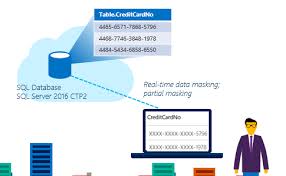Explore Dynamic Data Masking
DDM is a very simple security feature that can be fully built using T-SQL commands which we are familiar with, easy to use and also flexible to design.
Masking masks the sensitive data “on the fly” to protect sensitive data from non-privileged users using built-in or customized masking functions, without preventing them from retrieving the unmasked data.

Masking functions :-
Default function that masks the data according to the field data type:-
Binary, varbinary or image, a single byte of binary >> 0
Date and time data types >> 01.01.1900 00:00:00.0000000
Numeric data types >> zero value will be used to mask field
Email function >> First character of the email address and mask the rest of the email
Random >> masking function is used to mask any numeric data type by replacing the original value with a random value within the range specified in that function
Custom >> allows you to define mask for the specified field by exposing the first and last letters defined by the prefix and suffix and add a padding i.e. prefix, [padding value], suffix

Why is It Required ?
- Prevent unauthorized access
- Non-privileged application users
- Minimal impact on the application layer
- Without modifying existing queries of Application
- Limit exposure of sensitive data
- Designated database fields
- Policy-based security feature
- Data in the database are unchanged
How is it works ?
Pre-defined functions for masking and the ability to define your masks
- Default: That replaces characters with ‚XXXX‘ and Numbers with 0
- Email: That replaces a part before the @ and puts a ‚@XXXX.com‘ at the end
- Random: That replaces numbers with random values
- Custom String: In this function you can define your own padding string
LAB Work :
Step 1: To explore the feature we need to have a table
CREATE TABLE Employee( EmpID INT PRIMARY KEY, FirstName NVARCHAR(50) NOT NULL, LastName NVARCHAR(50) , Birthdate DATE , CurrentFlag BIT , Salary MONEY , EmailAddress NVARCHAR(50), SickLeave INT, SalesInsentive MONEY, NationalID NVARCHAR(15), PhoneNumber NVARCHAR(25));
Step 2: Create a user who is not authorized to view all data
CREATE USER hasan WITHOUT LOGIN; GRANT SELECT ON Employee TO hasan; Go EXECUTE AS USER = 'hasan'; SELECT * FROM Employee; REVERT;
Step 3: Now we’re going to mask a column
ALTER TABLE Employee ALTER COLUMN firstName varchar(10) MASKED WITH (FUNCTION = 'default()'); --After Apply Masking user will get masked value --------------------------------------------------------- EXECUTE AS USER = 'hasan'; SELECT * FROM Employee; REVERT;
Step 4 : Check the if admin user want to view the data then what will happen
Select * from Employee
Step 4 : Now we're going to mask different other columns having different data type and execute Select statement to view the change --Mask the Email address ----------------------------- ALTER TABLE Employee ALTER COLUMN EmailAddress nvarchar(50) MASKED WITH (FUNCTION = 'Email()'); --After Apply Masking to Employee table EXECUTE AS USER = 'hasan'; SELECT * FROM Employee; REVERT; --Mask to Random value --------------------------------------------------------- ALTER TABLE Employee ALTER COLUMN Salary int MASKED WITH (FUNCTION='random(1,9)'); EXECUTE AS USER = 'hasan'; SELECT * FROM Employee; REVERT; -- Mask to Random value ------------------------- ALTER TABLE Employee ALTER COLUMN PhoneNumber nvarchar(25) MASKED WITH (FUNCTION= 'partial(3,"XXXX",3)'); EXECUTE AS USER = 'hasan'; SELECT * FROM Employee; REVERT;
Step 5: Now we execute the unmask feature to view the change GRANT UNMASK TO hasan GO EXECUTE AS USER = 'hasan'; SELECT * FROM Employee; REVERT; GO REVOKE UNMASK TO hasan EXECUTE AS USER = 'hasan'; SELECT * FROM Employee; REVERT;
Step 6: Now we drop the mask feature to view the change
ALTER TABLE Employee ALTER COLUMN LastName nvarchar(50) MASKED WITH (FUNCTION = 'default()');EXECUTE AS USER = 'hasan'; SELECT * FROM Employee; REVERT; Go ALTER TABLE Employee ALTER COLUMN Lastname DROP MASKED; -- After Removing Masking EXECUTE AS USER = 'hasan'; SELECT * FROM Employee; REVERT; -- Recycle ------------- ALTER TABLE Employee ALTER COLUMN FirstName DROP MASKED; ALTER TABLE Employee ALTER COLUMN EmailAddress DROP MASKED; ALTER TABLE Employee ALTER COLUMN PhoneNumber DROP MASKED;